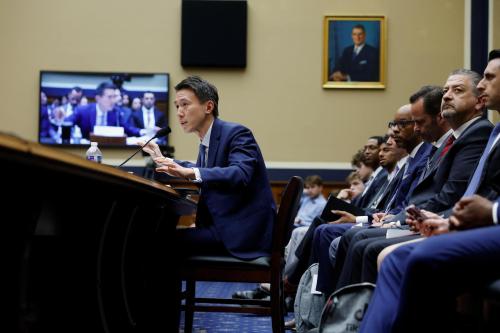The beauty of a pendulum is that once set in motion it can swing predictably forever. The difficulty is getting it to return to the middle. This seems to be the problem with regulation of derivatives.
In the 1990s, derivatives were widely heralded as new instruments that could improve the transference of risk. In 1999, then Federal Reserve Chairman Alan Greenspan stated: “By far the most significant event in finance during the past decade has been the extraordinary development and expansion of financial derivatives.” He went on to argue that they “enhance the ability to differentiate risk and allocate it to those investors most able and willing to take it. This unbundling improves the ability of the market to engender a set of product and asset prices far more calibrated to the value preferences of consumers than was possible before derivative markets were developed. The product and asset price signals enable entrepreneurs to finely allocate real capital facilities to produce those goods and services most valued by consumers, a process that has undoubtedly improved national productivity growth and standards of living.”
A Harmless Tool?
With general (although not universal) agreement in Washington that deregulation of financial services would benefit the economy, the Administration and Congress decided that the derivatives market should be largely unregulated. This position was codified in the Commodities Futures Modernization Act of 2000 and the Gramm-Leach-Bliley Act of 1999. Here is when the pendulum was set in motion.
Not all policymakers or investors were convinced that derivatives were harmless. Brooksley E. Born, Chair of the Commodity Futures Trading Commission, argued for tighter regulation of derivatives.In 2003, Warren Buffett famously stated that “derivatives are financial weapons of mass destruction, carrying dangers that, while now latent, are potentially lethal.”
Lessons of the Financial Crisis
When the financial crisis began in 2007, derivatives played a central role. AIG among others had sold a form of derivatives, credit default swaps (essentially default insurance), on billions of dollars of complex securities ultimately backed by shaky mortgages (collateralized debt obligationsor CDOs). AIG believed it was taking on little risk by selling these derivatives because a widespread housing price collapse was not seen as a possibility. Little capital had been set aside to cover potential losses on the swaps, largely because the buyers of the swaps relied on AIG’s stellar credit rating. When CDOs began dropping in value, AIG’s large derivative exposurecaused its bankruptcy and required a large government bailout to prevent its counterparties from taking losses and triggering additional financial instability.
It is no surprise then that the pendulum began to swing the other way.
The Dodd-Frank Wall Street Reform and Consumer Protection Act of 2010 devoted an entire title (Title VII) to re-regulating derivatives. Dodd-Frank set in place a multitude of new rules, each designed to address a different aspect of derivative regulation. Some of the more prominent ones are the Lincoln Amendment, single counterparty credit limits, clearing requirements, business conduct requirements on dealers, and varying specific rules, which apply to some, but not all, derivative contracts. The Volcker rule, which stipulates that banks cannot conduct “proprietary trading,” also affects the institutions that issue and trade derivatives.
Toward Regulation That Actually Works
One of the authors of this op-ed served in the Clinton Administration that approved financial deregulation, while the other served the Obama Administration that worked with Congress on Dodd-Frank. We want to make it clear that we both support derivatives regulation, but we also want to get that regulation right.
The bulk of derivatives are interest rate swaps, credit default swaps on corporate bonds and municipal and state bonds, commodity price derivatives, and currency swaps. These markets did not break down in the crisis and did not contribute to it. Many, many institutions took risky bets on mortgage-backed assets without any help from the derivatives markets.
Derivatives have value. Many families rely on 401(k) investments to fund their retirement, and the financial institutions that manage their money use derivatives. American companies use derivatives to lower their borrowing costs, manage their balance sheets, and hedge against risks. Airlines hedge against fuel price spikes, and exporters hedge against swings in exchange rates. Even Warren Buffett’s investment fund, Berkshire Hathaway, uses derivatives.
Dodd-Frank gave leeway to regulators to implement its rules. For derivatives trading, it gave varying responsibilities to both the Securities and Exchange Commission (SEC) and the Commodities Futures Trading Commission (CFTC) to write and enforce rules. Rather than merge these two regulators into a single body, Dodd-Frank maintained the multiple regulator approach, while requiring varying levels of regulatory coordination and consultation in rule writing. The Federal Reserve was given regulatory authority over the large financial institutions that issued most derivatives contracts in the past, and its proposed rules would greatly impact the derivatives market in the future.
It is worth asking if the myriad of rules put into place in Dodd-Frank to regulate derivatives can work together effectively and coherently. Congress, and the Financial Stability Oversight Council, should ensure that the different regulatory bodies work together to craft consistent rules of the game. Tackle the problems that emerged in the derivatives market and improve the economy’s stability, while still reaping the economic benefits derivatives can and do provide.
Let’s try and stop the pendulum in the right spot and avoid the wild swings.


Commentary
Op-edIt’s Time for Sensible Regulation of Derivatives
January 23, 2013